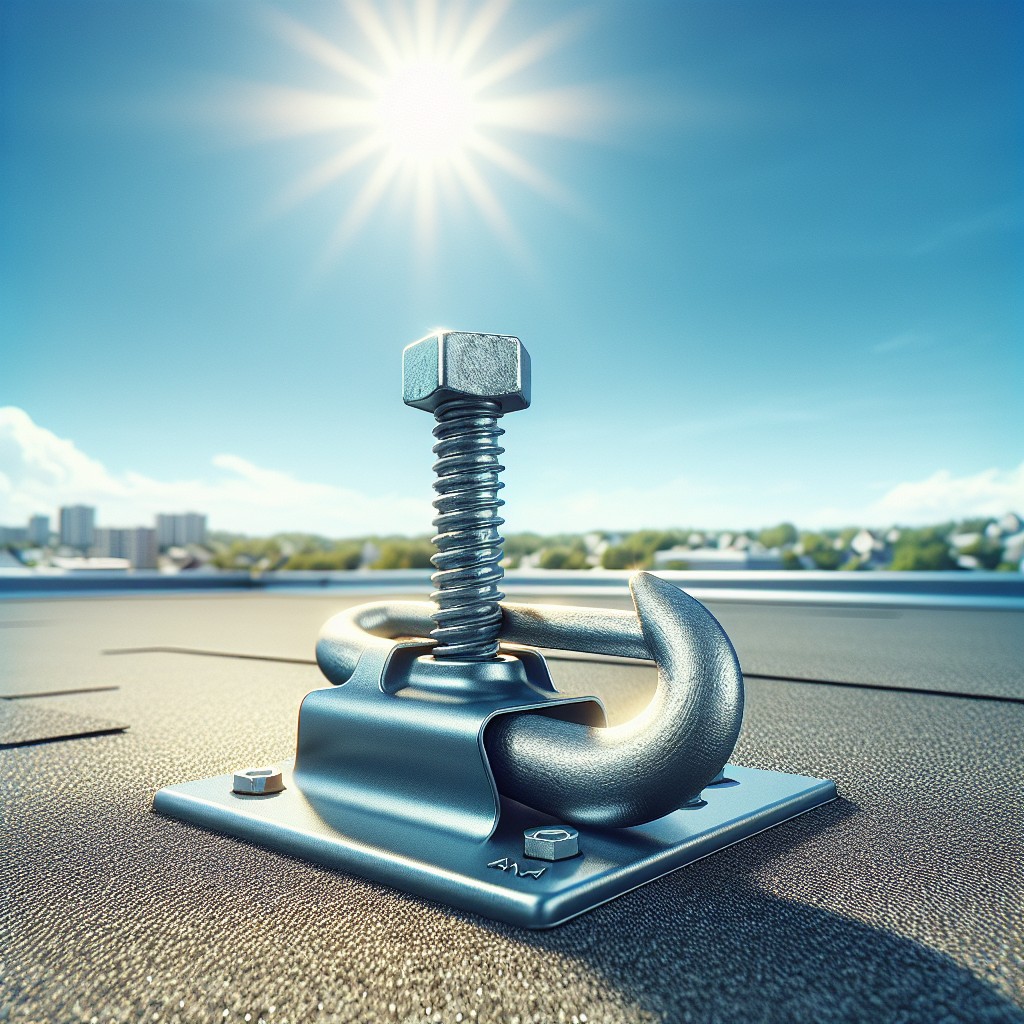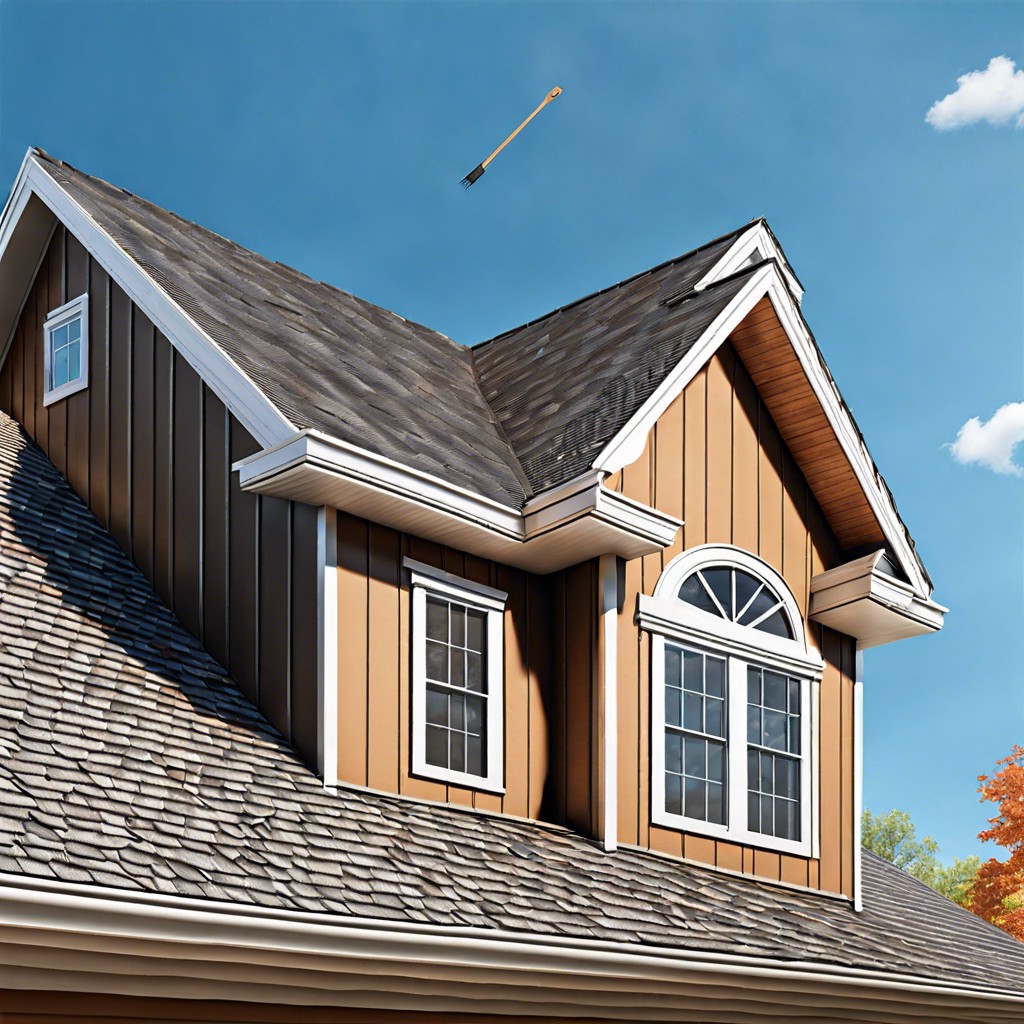Last updated on
Explore the necessity of a roof anchor because having the right one can greatly enhance your safety during roof chores or professional works.
Key takeaways:
- Safety Devices: Roof anchors serve as connection points for fall protection systems.
- Load Support: Anchors are designed to support the weight of a worker in case of a fall.
- Material and Design: Roof anchors can be made from steel or aluminum and must meet strength requirements.
- Versatility: Permanent and temporary options are available for different work and building structures.
- Importance of Roof Anchors: Minimize fall distances, increase confidence and productivity, comply with safety standards.
Definition of Roof Anchors

Roof anchors are secure points of attachment that are used for fall protection systems on rooftops. They play a critical role in preventing injuries and fatalities among workers engaging in tasks at heights.
Here are some key points explaining the concept:
- Safety Devices: They serve as a connection for lanyards, lifelines, and other forms of tie-off which ensure that workers do not fall off the roof in case of a slip or misstep.
- Load Support: Anchors are designed to support the weight of an individual in the event of a fall, including the dynamic forces involved.
- Material and Design: These devices can be made from a variety of materials such as steel or aluminum, and their design must meet specific strength requirements.
- Versatility: There are permanent and temporary options available, which can be chosen based on the nature of the work and the building structure.
Understanding these points is crucial in recognizing the value of roof anchors as essential components of rooftop safety measures.
Importance of Roof Anchors for Safety

Roof anchors are critical components in fall arrest and restraint systems, designed to protect workers from the risk of accidental falls during roof work.
These points of attachment are essential for securing lifelines, lanyards, and other forms of tie-off equipment that enable mobility while ensuring safety at heights.
Their presence helps to:
- Minimize potential fall distances by providing secure, fixed points for personal fall arrest systems.
- Increase the confidence and productivity of workers, knowing they are safeguarded against falls.
- Deter unsafe improvisations for anchorage in absence of proper equipment, which can lead to fatal accidents.
- Facilitate compliance with OSHA regulations and other safety standards, which mandate the use of roof anchors for certain types of work at elevation.
- Adapt to various roof styles and materials, offering versatile solutions for different building designs.
Key Features of Roof Anchors
Durability is a cornerstone of roof anchor systems, with materials typically comprising galvanized steel or aluminum to withstand harsh weather conditions and resist corrosion. Load capacity comes into play, as anchors must support the weight of a worker and equipment, necessitating compliance with minimum safety requirements which generally stipulate the ability to hold at least 5,000 pounds per person attached.
Flexibility is another paramount feature; anchors can be permanent fixtures for regular access roofs or portable units for one-time projects. Anchors should allow for easy attachment and detachment of lifelines or lanyards, ensuring seamless integration with personal fall arrest systems.
Compatibility with various roof designs is essential—whether the roof is flat, pitched, or has unique elements, an anchor must work without compromising the integrity of the roofing material. Moreover, roof anchors should be inconspicuous and not detract from the building’s aesthetic when not in use.
Lastly, ease of installation and use are significant. A complex system could lead to improper setup and increased risk. Clear instructions and straightforward design aid in ensuring proper usage and enhancing overall safety on the roof.
Different Types of Anchors
Temporary anchors provide a non-permanent solution for roof work, often used by contractors who need to move across various locations on the roof. They are designed for quick installation and removal, usually incorporating a fitting that can be clamped or bolted to the roof structure.
Permanent anchors, on the other hand, are fixed installations intended to offer a long-term safety solution. These are often installed during the construction phase and are integrated into the building’s design to provide consistent fall protection.
Mechanical anchors typically involve securing a point onto the structure through mechanical means such as expansion bolts which anchor into the roofing material or structure itself.
Adhesive anchors leverage epoxy or other strong adhesives to affix the anchor point to the roof surface. These require cure time and are dependent on the conditions of the roofing material for their strength.
Standing seam roof anchors are specially designed for metal roofs with standing seams, clamping onto the seams without puncturing the roof surface, preserving its integrity and warranty.
For residential roofs, there are specialized anchors that can be discretely installed and even painted to match the roofing materials, minimizing visual impact while providing secure attachment points.
Criteria for Selecting the Right Roof Anchor
Selecting the appropriate roof anchor necessitates careful consideration of various factors that ensure worker safety and compliance with regulations.
Assess the roof structure’s material and design since anchors must be compatible with metal, concrete, or wood surfaces.
Determine the type of work, either residential or commercial, to choose a permanent or temporary anchor system that accommodates specific job requirements.
The weight capacity of the anchor must exceed the combined weight of the worker, tools, and equipment.
Additionally, consider the environmental conditions, as anchors should withstand local weather extremes and potential corrosive elements.
Lastly, ensure that the selected roof anchor meets OSHA standards and is certified by reputable safety organizations.
Installation of Roof Anchors
Proper installation is critical to ensure roof anchors function effectively and safely. Installers must follow manufacturer instructions and OSHA guidelines to secure anchors correctly.
1. Surface Evaluation: Before any work commences, assess the roof to determine the most suitable locations for the anchor points, considering the roof’s material, structure, and slope.
2. Anchor Selection: Select the appropriate anchor type based on the roofing material. For instance, a metal roof may require a different anchor system compared to a tiled or shingle roof.
3. Mounting: Use the correct fasteners and ensure they penetrate sufficiently into structural members of the roof, such as rafters or trusses, for strong support.
4. Sealing: Apply waterproof sealants around the base of the anchor to prevent any potential water intrusion that could lead to leaks or structural damage.
5. Strength Testing: Once installed, perform a pull-test if required by the manufacturer or safety standards to verify the anchor can support the designated load.
6. Clear Documentation: Keep a record of the installation details, including location, type of anchor, date of installation, and results of any strength tests for future reference and inspections.
Remember, installation should always be done by a qualified professional to guarantee safety and compliance with all relevant regulations.
Maintenance and Inspection of Roof Anchors
Regular maintenance and inspection are crucial to ensure the reliability and safety of roof anchor systems. The longevity and effectiveness of these systems heavily rely on adherence to the following guidelines:
- Inspect roof anchors at least annually, or more frequently if local regulations or manufacturers’ guidelines dictate.
- Examine for any signs of corrosion, wear, or damage to the anchor points, eyelets, or attached components.
- Check that all fasteners and connections are secure and have not loosened over time due to weather conditions or building movement.
- Verify that movable parts operate freely and lubricate them as necessary to prevent seizing or increased resistance during use.
- Confirm that the roof substrate around the anchor remains intact and has not been compromised by moisture, decay, or structural shifts.
- Update documentation to reflect inspections, maintenance activities, and any corrective actions taken.
- Always use a competent and qualified individual to perform these inspections to ensure adherence to safety protocols.
A well-maintained roof anchor is fundamental for preventing accidents and ensuring a safe work environment for those required to perform tasks at heights.
Safety Standards and Compliance
Adherence to safety standards and compliance regulations assures the efficacy and reliability of roof anchors. The Occupational Safety and Health Administration (OSHA) outlines strict guidelines that must be followed. For instance, OSHA standard 1910.140(c)(13) specifies that roof anchors must be capable of supporting at least 5,000 pounds per person attached.
Furthermore, the American National Standards Institute (ANSI) provides a set of criteria under ANSI Z359 that categorize various fall protection equipment, including roof anchors.
It is imperative to understand local building codes as they can have additional requirements for the installation and use of roof anchors. Compliance with these building codes not only ensures user safety but also protects against liability.
Regular training for personnel is another critical aspect of safety, ensuring individuals are aware of best practices and the correct use of equipment.
Lastly, third-party certifications from organizations such as Underwriters Laboratories (UL) serve as an additional layer of assurance that the roof anchors meet rigorous safety and performance standards.
Pros and Cons of Various Roof Anchor Systems
Permanent anchors offer long-term solutions and ensure consistent placement for regular access. Their durability and low maintenance make them a practical choice for buildings that require frequent rooftop work. However, they are more visible and require professional installation, which could affect a building’s aesthetics and necessitate upfront costs.
Temporary anchors provide flexibility and portability, ideal for short-term projects across multiple sites. They are typically more cost-effective and less intrusive to install, but they require careful setup each time they are used to ensure safety. These systems may also require more frequent inspections before each use.
Mechanical anchors allow for adjustability and are suited for various roof pitches and surfaces. While this versatility is an advantage, the complexity of their design means they generally require a higher skill level to install correctly, potentially leading to increased labor costs.
Weighted anchors are non-penetrative options that preserve roof integrity and are easily moved as needed. The lack of penetration can be particularly beneficial for waterproofing concerns. On the flip side, these systems can be bulky and require significant storage space, and their weight means they aren’t suitable for all roof structures.
It’s important to note that the selection of a roof anchor system should align with the specific roofing material, structural capabilities, and the frequency and nature of the tasks to be performed on the roof.
Case Studies: Effective Use of Roof Anchors
In residential construction, roof anchors proved crucial when a crew in Colorado worked on a steep-slope, high-pitched roof. The team utilized fixed-point anchors securely attached to the rafters, allowing for a full range of motion while ensuring each worker’s safety with a personal fall arrest system. Their effective use prevented falls during high wind periods and saved a worker who slipped on loose shingles.
During routine maintenance of a commercial high-rise, temporary roof anchors were employed to facilitate window washing and façade repairs. The anchors, adhering to OSHA standards, supported the suspended scaffolding system. This not only provided a secure point of attachment but also did not damage the building’s structure upon removal, demonstrating the versatility and non-invasiveness of temporary anchors.
A solar panel installation project in California illustrates the benefits of adjustable roof anchors. These anchors accommodated various roof styles and pitches, offering a secure attachment for safety lines as installers worked across the complex contours of the roofs. With the help of these anchors, installers navigated the workspace efficiently and without incident, showcasing the anchors’ adaptability and reliability.
These examples reflect roof anchors’ pivotal role in ensuring worker safety and highlight considerations for their selection based on the task and roof type. Properly chosen and used, roof anchors become an indispensable component of a holistic approach to fall prevention on the worksite.
FAQ
What are roof anchors for?
Roof anchors are utilized for the primary purpose of protecting workers and contractors from falls when engaged in elevated work tasks such as window cleaning or gutter maintenance.
Do roof anchors damage the roof?
Roof anchors, while not causing structural damage through penetration, can still potentially damage the roof if weight-related issues are mismanaged.
Can you leave a roof anchor on the roof?
Yes, some roof anchors can be left on the roof as they are designed for permanent installation and immediate use by employees accessing the roof.
What is the life expectancy of a roof anchor?
The life expectancy of a roof anchor system, considering routine inspection and maintenance, is typically between 25 to 30 years.
How often should roof anchors be inspected and replaced?
Roof anchors should be inspected at least once a year and replaced every few years or sooner if they show signs of wear or damage.
Are there specific types of roofs that roof anchors cannot be used on?
Roof anchors cannot be used on roofs made of brittle materials, like clay or slate, because these might crack under pressure.
What safety measures should be implemented when using roof anchors?
When using roof anchors, implement safety measures like wearing proper PPE, ensuring anchors are installed by competent professionals, frequently checking their condition, and following load capacity guidelines strictly.




